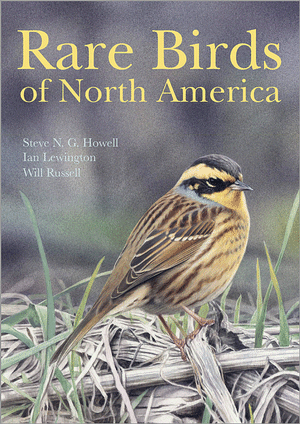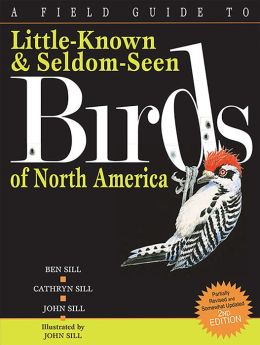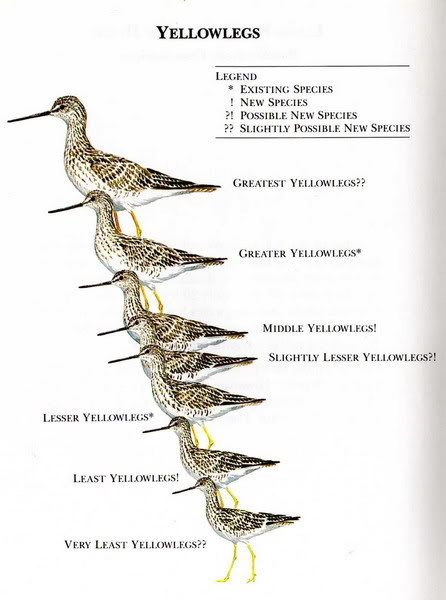I've never met Steve N. G. Howell, but if I had the opportunity I think I might be too intimidated, and beg off with a fake illness or a made-up death in the family. You think you're a good birder? Well, this guy wrote the book on molt. He literally wrote a book about molt.
At a time when most field guide authors are aiming for the sweet-spot middle with general American bird guides, Howell has cast off ornithological (and financial?) conventions and found a niche taking on especially difficult or outlier birding topics: gulls; petrels; hummingbirds; molt. He's a bird guide writer's bird guide writer, someone who seems to feel no need to dumb things down for new birders. He's back at it with Rare Birds of North America, a guide to avian vagrants and vagrancy.
It's mouthwatering ground to cover. Howell, along with coauthors Ian Lewington and Will Russell, cover 262 species of American vagrants, detailing their plumage and habits, of course, but more importantly the potential reasons behind their vagrancy patterns. In fact, the "Migration and Vagrancy in Birds" chapter at the beginning is worth the sticker price all by itself. For hardcore birders, it's the kind of book that makes you want to stop reading, and I mean that in a good way.
But it ain't perfect. As with some of Howell's other titles, especially Gulls of the Americas, it's organized fairly unhelpfully. [A quick note on Gulls of the Americas: can we please get a reworked and updated edition? No group needs a comprehensive ID guide more than gulls, but GotA needs a lot of fixing. My two cents: better photos (with illustrated plates for guidance), better organization, and drop the South American birds.] In Rare Birds, species are broken up into groups, such as Wading Birds or Aerial Landbirds, and then those groups are typically broken up again into those species originating in the Old World and the New World. The effect of the New World/Old World split is disorienting - for example, there are sections of flycatchers separated by 58 pages of Old World robins, warblers and wagtails - without being useful. Additionally, the book lacks usefulness as an identification guide because of its sparse treatment, both in plates and in print, of "similar species."
Rare Birds of North America continues Howell's brave exploration into areas of birding heretofore unknown in print. Though this book is imperfect, and will likely become outdated as a reference as new records pile up, it's a bold examination of the science behind vagrancy, and will hopefully push some birders to find noteworthy additions of their own.
Sunday, February 9, 2014
Book Review: Rare Birds of North America
Labels: book review, gulls, rare birds, steve n.g. howell
Tuesday, June 25, 2013
Book Review: A Field Guide to Little-Known and Seldom Seen Birds of North America
A Field Guide to Little-Known and Seldom Seen Birds of North America is just a damn funny, well-observed, thorough and insightful parody, a book that rolls gleefully rolls in the mud of birding nerdiness and comes out squeaky clean. It's a book seemingly borne out of that familiar feeling of not birding - of being stuck behind a desk or in a classroom thinking about birds and doodling them in the margins of your notebook. It's imaginative, is what I'm saying, exploring the same sense of wonder that makes birders birders in the first place.
If you hadn't figured it out, it's a field guide to fake birds. Beautifully illustrated by John Sill and authored by John and his almost-certainly relatives Ben and Cathryn Sill (their relationship isn't made clear anywhere in the book), the bulk of the book is made up of fully-fleshed invented species. Comedically, the species run the gamut from keen birding observations (see: the Middle, Least and Very Least Yellowlegs complex, or the Small Flycatcher) to plumage jokes (see: Military Warbler or Texas Warbler) to straight-up, satisfying puns (see: the Spring Kite, a raptor with a long tail and a diamond shape that perches by tangling in a tree).
It's tempting to skim through and laugh at the illustrations, but the book rewards cover-to-cover reading (or punishes, depending on your stomach for worn-out groaners including the "Under the Bleachers by I.P. Freely" family). Good riffs on field guide self-seriousness and biologic mumbo-jumbo are there for the taking. Buy this book and give it to a birder friend of yours, they'll recognize it as the work of kindred spirits.
Monday, October 8, 2012
Book Review: An Eternity of Eagles by Stephen J. Bobio
It's a necessity of field guides that they only cover the biological aspects of birds. Birders want to know which birds are which, and what it means when that one has an eyestripe and that one doesn't, and what it means when that one has a call like this and that one has a call like that. Reduced to these flat comparisons, though, birders can easily forget the real power and living connections humans can have - used to have? - with birds.
An Eternity of Eagles is not a field guide but a "human history" of eagles. The book begins with physiology - what we humans have learned about eagles through scientific study - but quickly moves to how humans and eagles have interacted in other fields: art, hunting, folklore. That feeling we get seeing an eagle float overhead is primal - rooted in mankind's earliest days of wild living. Bobio's book digs at that feeling, and traces our awe and respect of eagles from early cave drawings through to Native American totem poles, Greek mythology and to the modern symbol of America.
I think birders will benefit from reading this book and remembering that our shared history goes far beyond JJ Audubon or RT Peterson. After all, despite all our scientific advances, those field guide pages will some day just be just be another set of confusing artifacts sifted through by future archaeologists trying to figure out what our civilization was all about. [Also, there's a crazy photo of a guy aiming a shotgun at a Golden Eagle from out the door of an airplane. We're terrible].
An Eternity of Eagles by Stephen J. Bodio is published by Lyons Press and is available here on Amazon.




